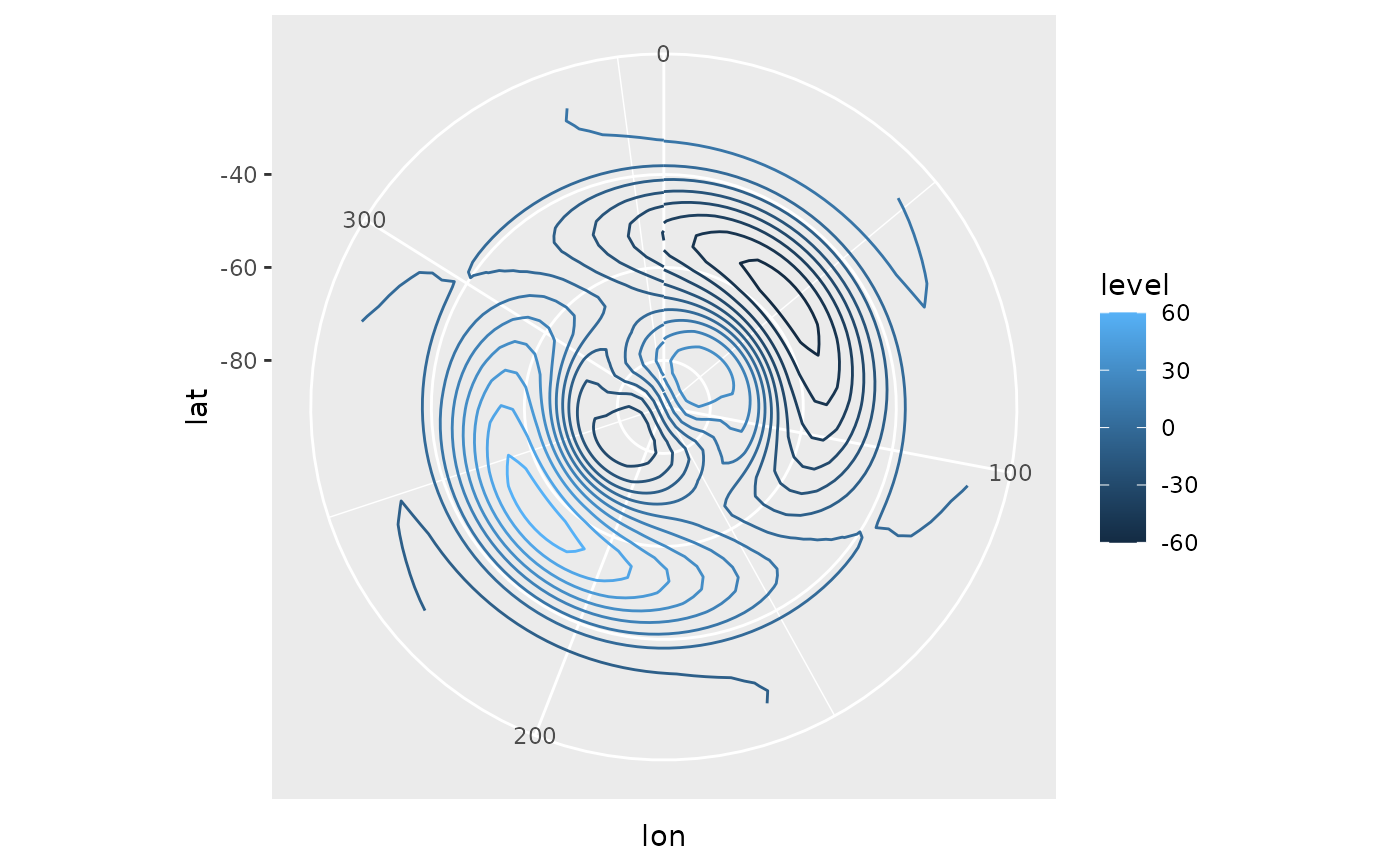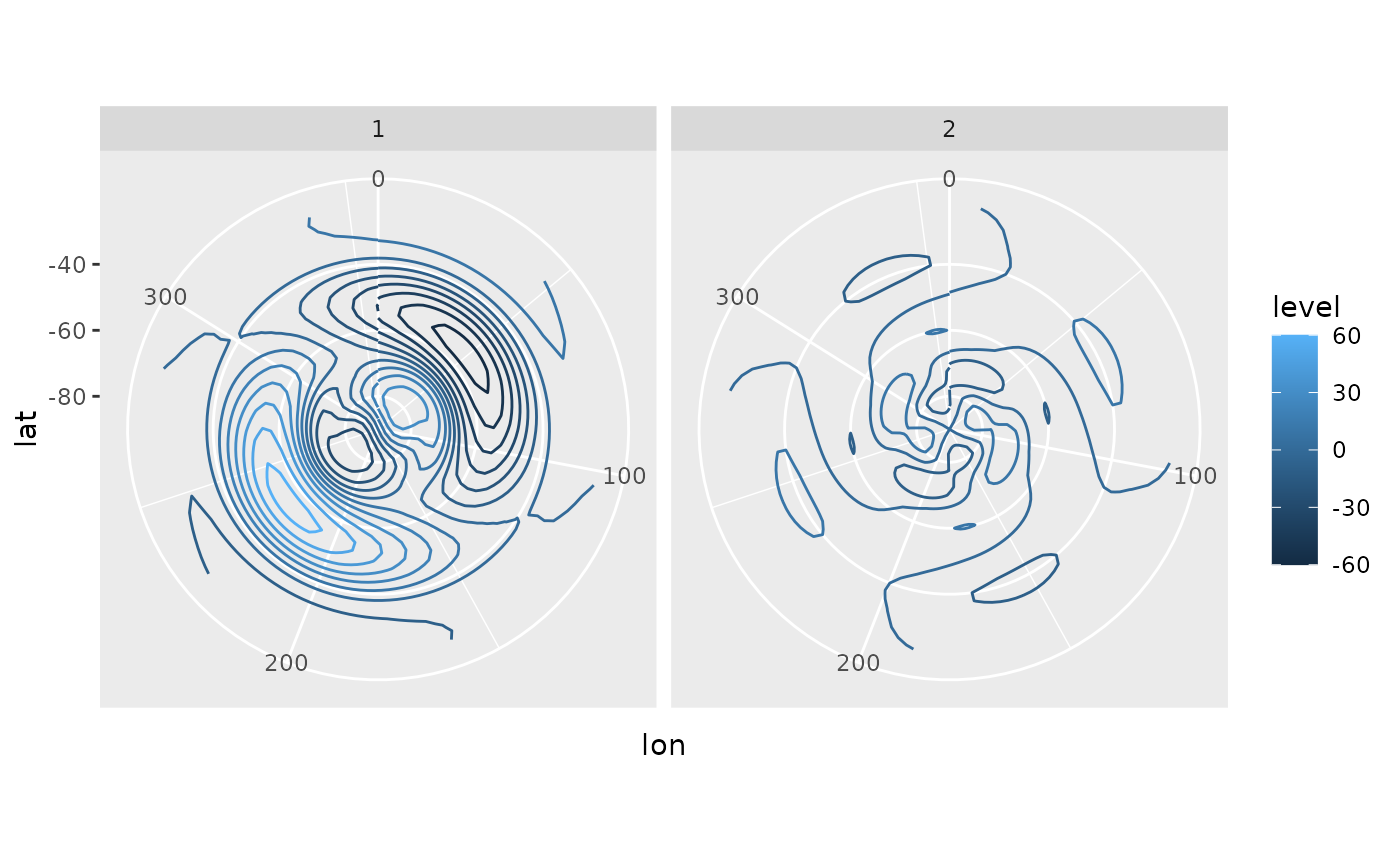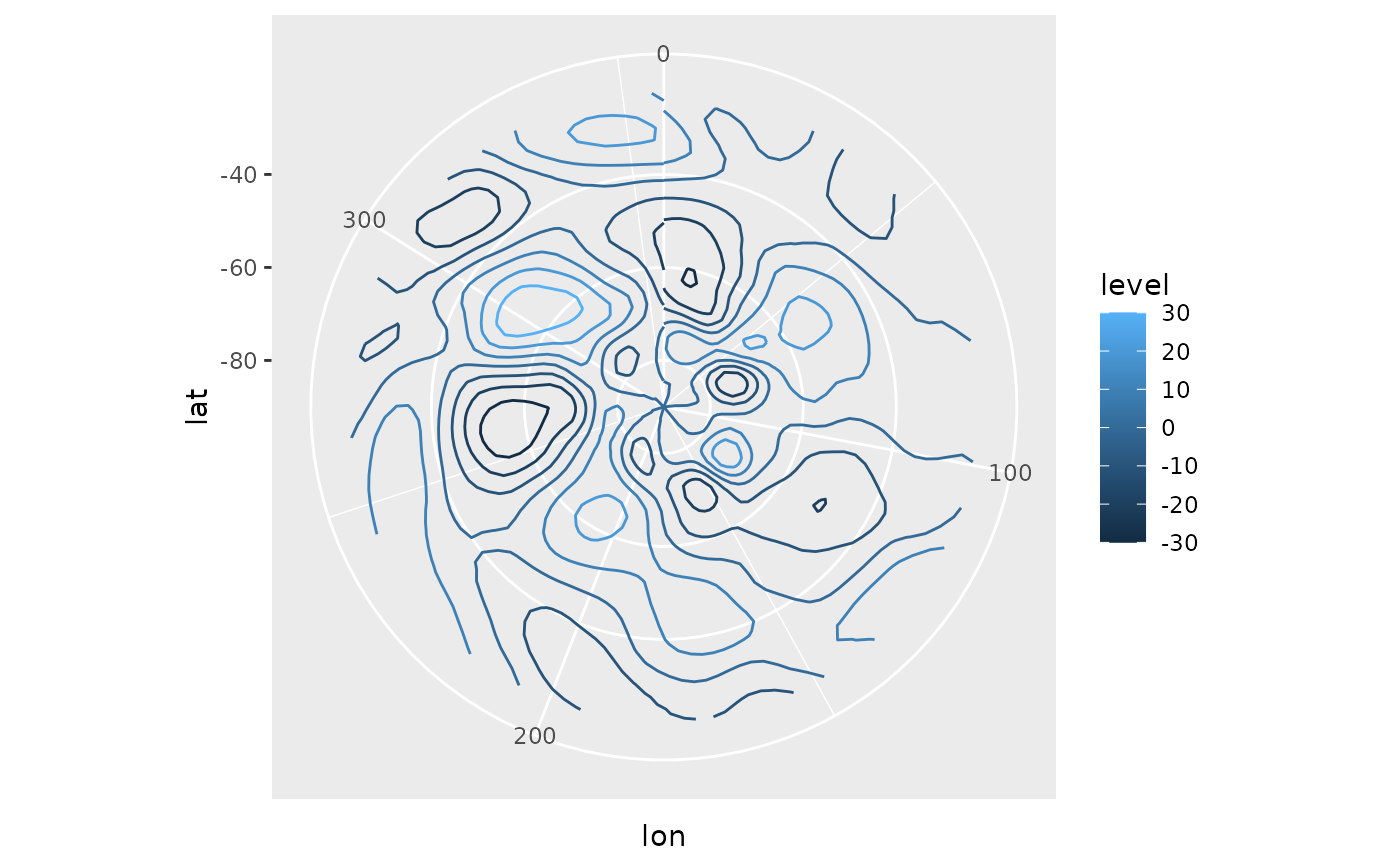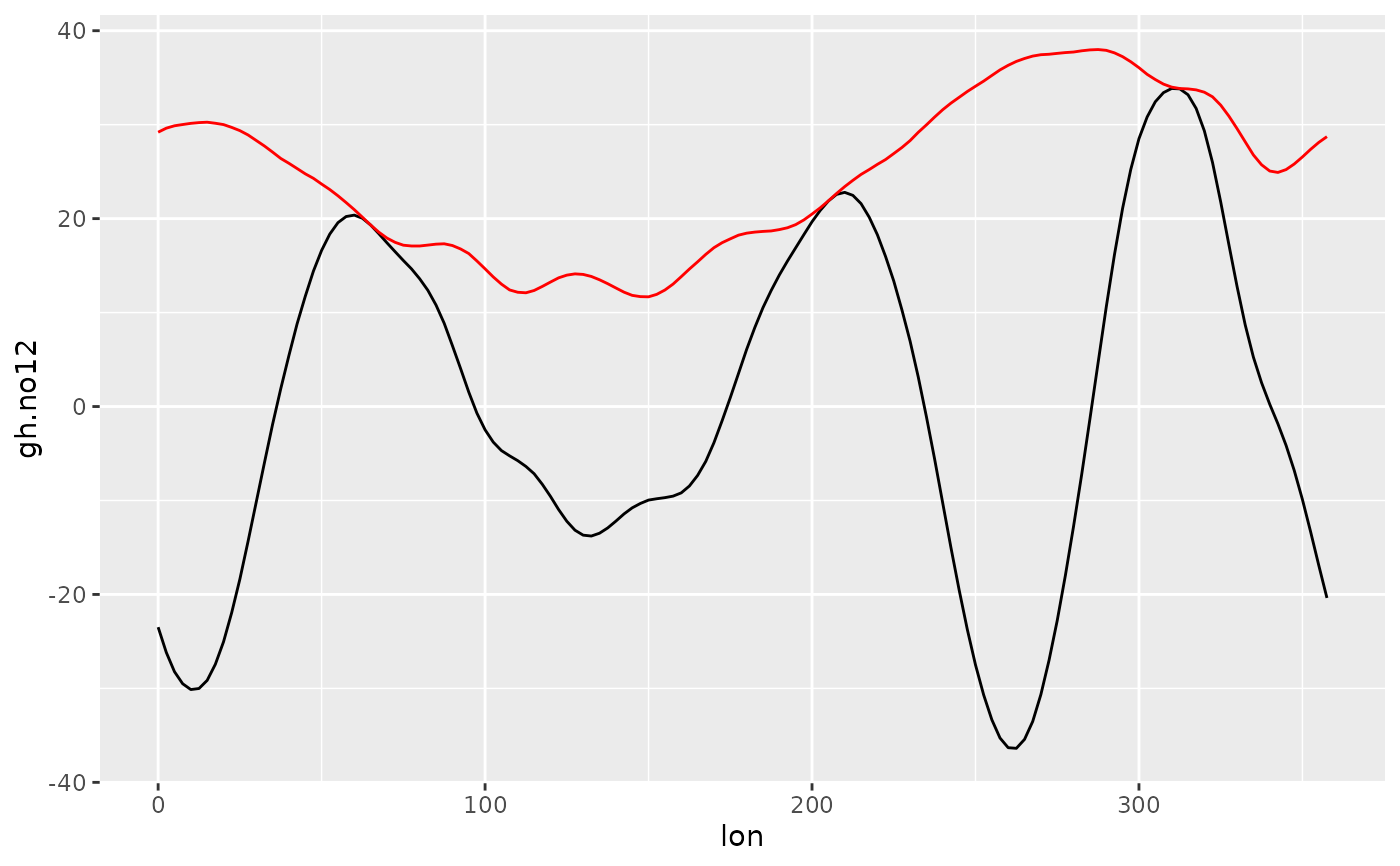Use fft() to fit, filter and reconstruct signals in the frequency domain, as
well as to compute the wave envelope.
Arguments
- y
numeric vector to transform
- k
numeric vector of wave numbers
- x
numeric vector of locations (in radians)
- amplitude
numeric vector of amplitudes
- phase
numeric vector of phases
- wave
optional list output from
FitWave- sum
whether to perform the sum or not (see Details)
- action
integer to disambiguate action for k = 0 (see Details)
Value
FitWaves returns a a named list with components
- k
wavenumbers
- amplitude
amplitude of each wavenumber
- phase
phase of each wavenumber in radians
- r2
explained variance of each wavenumber
BuildWave returns a vector of the same length of x with the reconstructed
vector if sum is TRUE or, instead, a list with components
- k
wavenumbers
- x
the vector of locations
- y
the reconstructed signal of each wavenumber
FilterWave and WaveEnvelope return a vector of the same length as y
`
Details
FitWave performs a fourier transform of the input vector
and returns a list of parameters for each wave number kept.
The amplitude (A), phase (\(\phi\)) and wave number (k) satisfy:
$$y = \sum A cos((x - \phi)k)$$
The phase is calculated so that it lies between 0 and \(2\pi/k\) so it
represents the location (in radians) of the first maximum of each wave number.
For the case of k = 0 (the mean), phase is arbitrarily set to 0.
BuildWave is FitWave's inverse. It reconstructs the original data for
selected wavenumbers. If sum is TRUE (the default) it performs the above
mentioned sum and returns a single vector. If is FALSE, then it returns a list
of k vectors consisting of the reconstructed signal of each wavenumber.
FilterWave filters or removes wavenumbers specified in k. If k is positive,
then the result is the reconstructed signal of y only for wavenumbers
specified in k, if it's negative, is the signal of y minus the wavenumbers
specified in k. The argument action must be be manually set to -1 or +1
if k=0.
WaveEnvelope computes the wave envelope of y following Zimin (2003). To compute
the envelope of only a restricted band, first filter it with FilterWave.
References
Zimin, A.V., I. Szunyogh, D.J. Patil, B.R. Hunt, and E. Ott, 2003: Extracting Envelopes of Rossby Wave Packets. Mon. Wea. Rev., 131, 1011–1017, doi:10.1175/1520-0493(2003)131<1011:EEORWP>2.0.CO;2
See also
Other meteorology functions:
Derivate(),
EOF(),
GeostrophicWind(),
WaveFlux(),
thermodynamics
Examples
# Build a wave with specific wavenumber profile
waves <- list(k = 1:10,
amplitude = rnorm(10)^2,
phase = runif(10, 0, 2*pi/(1:10)))
x <- BuildWave(seq(0, 2*pi, length.out = 60)[-1], wave = waves)
# Just fancy FFT
FitWave(x, k = 1:10)
#> $amplitude
#> [1] 0.031639811 0.222183229 2.275286190 0.020037645 0.521286930 0.006932046
#> [7] 0.261543066 0.011468912 1.948771665 0.241891010
#>
#> $phase
#> [1] 4.80636512 0.23540576 1.96704693 0.10808491 0.36202644 0.26751500
#> [7] 0.13034289 0.70324492 0.05378108 0.20742644
#>
#> $k
#> [1] 1 2 3 4 5 6 7 8 9 10
#>
#> $r2
#> [1] 1.062237e-04 5.238128e-03 5.493203e-01 4.260366e-05 2.883416e-02
#> [6] 5.098900e-06 7.258385e-03 1.395719e-05 4.029726e-01 6.208591e-03
#>
# Extract only specific wave components
plot(FilterWave(x, 1), type = "l")
 plot(FilterWave(x, 2), type = "l")
plot(FilterWave(x, 2), type = "l")
 plot(FilterWave(x, 1:4), type = "l")
plot(FilterWave(x, 1:4), type = "l")
 # Remove components from the signal
plot(FilterWave(x, -4:-1), type = "l")
# Remove components from the signal
plot(FilterWave(x, -4:-1), type = "l")
 # The sum of the two above is the original signal (minus floating point errors)
all.equal(x, FilterWave(x, 1:4) + FilterWave(x, -4:-1))
#> [1] TRUE
# The Wave envelopes shows where the signal is the most "wavy".
plot(x, type = "l", col = "grey")
lines(WaveEnvelope(x), add = TRUE)
#> Warning: "add" is not a graphical parameter
# The sum of the two above is the original signal (minus floating point errors)
all.equal(x, FilterWave(x, 1:4) + FilterWave(x, -4:-1))
#> [1] TRUE
# The Wave envelopes shows where the signal is the most "wavy".
plot(x, type = "l", col = "grey")
lines(WaveEnvelope(x), add = TRUE)
#> Warning: "add" is not a graphical parameter
 # Examples with real data
data(geopotential)
library(data.table)
# January mean of geopotential height
jan <- geopotential[month(date) == 1, .(gh = mean(gh)), by = .(lon, lat)]
# Stationary waves for each latitude
jan.waves <- jan[, FitWave(gh, 1:4), by = .(lat)]
library(ggplot2)
ggplot(jan.waves, aes(lat, amplitude, color = factor(k))) +
geom_line()
# Examples with real data
data(geopotential)
library(data.table)
# January mean of geopotential height
jan <- geopotential[month(date) == 1, .(gh = mean(gh)), by = .(lon, lat)]
# Stationary waves for each latitude
jan.waves <- jan[, FitWave(gh, 1:4), by = .(lat)]
library(ggplot2)
ggplot(jan.waves, aes(lat, amplitude, color = factor(k))) +
geom_line()
 # Build field of wavenumber 1
jan[, gh.1 := BuildWave(lon*pi/180, wave = FitWave(gh, 1)), by = .(lat)]
#> lon lat gh gh.1
#> <num> <num> <num> <num>
#> 1: 0.0 -22.5 3167.817 11.73417
#> 2: 2.5 -22.5 3166.253 11.84884
#> 3: 5.0 -22.5 3165.204 11.94097
#> 4: 7.5 -22.5 3164.823 12.01036
#> 5: 10.0 -22.5 3165.247 12.05689
#> ---
#> 4028: 347.5 -90.0 2701.129 0.00000
#> 4029: 350.0 -90.0 2701.129 0.00000
#> 4030: 352.5 -90.0 2701.129 0.00000
#> 4031: 355.0 -90.0 2701.129 0.00000
#> 4032: 357.5 -90.0 2701.129 0.00000
ggplot(jan, aes(lon, lat)) +
geom_contour(aes(z = gh.1, color = after_stat(level))) +
coord_polar()
# Build field of wavenumber 1
jan[, gh.1 := BuildWave(lon*pi/180, wave = FitWave(gh, 1)), by = .(lat)]
#> lon lat gh gh.1
#> <num> <num> <num> <num>
#> 1: 0.0 -22.5 3167.817 11.73417
#> 2: 2.5 -22.5 3166.253 11.84884
#> 3: 5.0 -22.5 3165.204 11.94097
#> 4: 7.5 -22.5 3164.823 12.01036
#> 5: 10.0 -22.5 3165.247 12.05689
#> ---
#> 4028: 347.5 -90.0 2701.129 0.00000
#> 4029: 350.0 -90.0 2701.129 0.00000
#> 4030: 352.5 -90.0 2701.129 0.00000
#> 4031: 355.0 -90.0 2701.129 0.00000
#> 4032: 357.5 -90.0 2701.129 0.00000
ggplot(jan, aes(lon, lat)) +
geom_contour(aes(z = gh.1, color = after_stat(level))) +
coord_polar()
 # Build fields of wavenumber 1 and 2
waves <- jan[, BuildWave(lon*pi/180, wave = FitWave(gh, 1:2), sum = FALSE), by = .(lat)]
waves[, lon := x*180/pi]
#> lat k x y lon
#> <num> <num> <num> <num> <num>
#> 1: -22.5 1 0.00000000 11.73417 0.0
#> 2: -22.5 1 0.04363323 11.84884 2.5
#> 3: -22.5 1 0.08726646 11.94097 5.0
#> 4: -22.5 1 0.13089969 12.01036 7.5
#> 5: -22.5 1 0.17453293 12.05689 10.0
#> ---
#> 8060: -90.0 2 6.06501915 0.00000 347.5
#> 8061: -90.0 2 6.10865238 0.00000 350.0
#> 8062: -90.0 2 6.15228561 0.00000 352.5
#> 8063: -90.0 2 6.19591884 0.00000 355.0
#> 8064: -90.0 2 6.23955208 0.00000 357.5
ggplot(waves, aes(lon, lat)) +
geom_contour(aes(z = y, color = after_stat(level))) +
facet_wrap(~k) +
coord_polar()
# Build fields of wavenumber 1 and 2
waves <- jan[, BuildWave(lon*pi/180, wave = FitWave(gh, 1:2), sum = FALSE), by = .(lat)]
waves[, lon := x*180/pi]
#> lat k x y lon
#> <num> <num> <num> <num> <num>
#> 1: -22.5 1 0.00000000 11.73417 0.0
#> 2: -22.5 1 0.04363323 11.84884 2.5
#> 3: -22.5 1 0.08726646 11.94097 5.0
#> 4: -22.5 1 0.13089969 12.01036 7.5
#> 5: -22.5 1 0.17453293 12.05689 10.0
#> ---
#> 8060: -90.0 2 6.06501915 0.00000 347.5
#> 8061: -90.0 2 6.10865238 0.00000 350.0
#> 8062: -90.0 2 6.15228561 0.00000 352.5
#> 8063: -90.0 2 6.19591884 0.00000 355.0
#> 8064: -90.0 2 6.23955208 0.00000 357.5
ggplot(waves, aes(lon, lat)) +
geom_contour(aes(z = y, color = after_stat(level))) +
facet_wrap(~k) +
coord_polar()
 # Field with waves 0 to 2 filtered
jan[, gh.no12 := gh - BuildWave(lon*pi/180, wave = FitWave(gh, 0:2)), by = .(lat)]
#> lon lat gh gh.1 gh.no12
#> <num> <num> <num> <num> <num>
#> 1: 0.0 -22.5 3167.817 11.73417 5.858149
#> 2: 2.5 -22.5 3166.253 11.84884 4.006104
#> 3: 5.0 -22.5 3165.204 11.94097 2.689758
#> 4: 7.5 -22.5 3164.823 12.01036 2.061137
#> 5: 10.0 -22.5 3165.247 12.05689 2.261535
#> ---
#> 4028: 347.5 -90.0 2701.129 0.00000 0.000000
#> 4029: 350.0 -90.0 2701.129 0.00000 0.000000
#> 4030: 352.5 -90.0 2701.129 0.00000 0.000000
#> 4031: 355.0 -90.0 2701.129 0.00000 0.000000
#> 4032: 357.5 -90.0 2701.129 0.00000 0.000000
ggplot(jan, aes(lon, lat)) +
geom_contour(aes(z = gh.no12, color = after_stat(level))) +
coord_polar()
# Field with waves 0 to 2 filtered
jan[, gh.no12 := gh - BuildWave(lon*pi/180, wave = FitWave(gh, 0:2)), by = .(lat)]
#> lon lat gh gh.1 gh.no12
#> <num> <num> <num> <num> <num>
#> 1: 0.0 -22.5 3167.817 11.73417 5.858149
#> 2: 2.5 -22.5 3166.253 11.84884 4.006104
#> 3: 5.0 -22.5 3165.204 11.94097 2.689758
#> 4: 7.5 -22.5 3164.823 12.01036 2.061137
#> 5: 10.0 -22.5 3165.247 12.05689 2.261535
#> ---
#> 4028: 347.5 -90.0 2701.129 0.00000 0.000000
#> 4029: 350.0 -90.0 2701.129 0.00000 0.000000
#> 4030: 352.5 -90.0 2701.129 0.00000 0.000000
#> 4031: 355.0 -90.0 2701.129 0.00000 0.000000
#> 4032: 357.5 -90.0 2701.129 0.00000 0.000000
ggplot(jan, aes(lon, lat)) +
geom_contour(aes(z = gh.no12, color = after_stat(level))) +
coord_polar()
 # Much faster
jan[, gh.no12 := FilterWave(gh, -2:0), by = .(lat)]
#> lon lat gh gh.1 gh.no12
#> <num> <num> <num> <num> <num>
#> 1: 0.0 -22.5 3167.817 11.73417 5.858149
#> 2: 2.5 -22.5 3166.253 11.84884 4.006104
#> 3: 5.0 -22.5 3165.204 11.94097 2.689758
#> 4: 7.5 -22.5 3164.823 12.01036 2.061137
#> 5: 10.0 -22.5 3165.247 12.05689 2.261535
#> ---
#> 4028: 347.5 -90.0 2701.129 0.00000 0.000000
#> 4029: 350.0 -90.0 2701.129 0.00000 0.000000
#> 4030: 352.5 -90.0 2701.129 0.00000 0.000000
#> 4031: 355.0 -90.0 2701.129 0.00000 0.000000
#> 4032: 357.5 -90.0 2701.129 0.00000 0.000000
ggplot(jan, aes(lon, lat)) +
geom_contour(aes(z = gh.no12, color = after_stat(level))) +
coord_polar()
# Much faster
jan[, gh.no12 := FilterWave(gh, -2:0), by = .(lat)]
#> lon lat gh gh.1 gh.no12
#> <num> <num> <num> <num> <num>
#> 1: 0.0 -22.5 3167.817 11.73417 5.858149
#> 2: 2.5 -22.5 3166.253 11.84884 4.006104
#> 3: 5.0 -22.5 3165.204 11.94097 2.689758
#> 4: 7.5 -22.5 3164.823 12.01036 2.061137
#> 5: 10.0 -22.5 3165.247 12.05689 2.261535
#> ---
#> 4028: 347.5 -90.0 2701.129 0.00000 0.000000
#> 4029: 350.0 -90.0 2701.129 0.00000 0.000000
#> 4030: 352.5 -90.0 2701.129 0.00000 0.000000
#> 4031: 355.0 -90.0 2701.129 0.00000 0.000000
#> 4032: 357.5 -90.0 2701.129 0.00000 0.000000
ggplot(jan, aes(lon, lat)) +
geom_contour(aes(z = gh.no12, color = after_stat(level))) +
coord_polar()
 # Using positive numbers returns the field
jan[, gh.only12 := FilterWave(gh, 2:1), by = .(lat)]
#> lon lat gh gh.1 gh.no12 gh.only12
#> <num> <num> <num> <num> <num> <num>
#> 1: 0.0 -22.5 3167.817 11.73417 5.858149 11.17110
#> 2: 2.5 -22.5 3166.253 11.84884 4.006104 11.45865
#> 3: 5.0 -22.5 3165.204 11.94097 2.689758 11.72661
#> 4: 7.5 -22.5 3164.823 12.01036 2.061137 11.97348
#> 5: 10.0 -22.5 3165.247 12.05689 2.261535 12.19776
#> ---
#> 4028: 347.5 -90.0 2701.129 0.00000 0.000000 0.00000
#> 4029: 350.0 -90.0 2701.129 0.00000 0.000000 0.00000
#> 4030: 352.5 -90.0 2701.129 0.00000 0.000000 0.00000
#> 4031: 355.0 -90.0 2701.129 0.00000 0.000000 0.00000
#> 4032: 357.5 -90.0 2701.129 0.00000 0.000000 0.00000
ggplot(jan, aes(lon, lat)) +
geom_contour(aes(z = gh.only12, color = after_stat(level))) +
coord_polar()
# Using positive numbers returns the field
jan[, gh.only12 := FilterWave(gh, 2:1), by = .(lat)]
#> lon lat gh gh.1 gh.no12 gh.only12
#> <num> <num> <num> <num> <num> <num>
#> 1: 0.0 -22.5 3167.817 11.73417 5.858149 11.17110
#> 2: 2.5 -22.5 3166.253 11.84884 4.006104 11.45865
#> 3: 5.0 -22.5 3165.204 11.94097 2.689758 11.72661
#> 4: 7.5 -22.5 3164.823 12.01036 2.061137 11.97348
#> 5: 10.0 -22.5 3165.247 12.05689 2.261535 12.19776
#> ---
#> 4028: 347.5 -90.0 2701.129 0.00000 0.000000 0.00000
#> 4029: 350.0 -90.0 2701.129 0.00000 0.000000 0.00000
#> 4030: 352.5 -90.0 2701.129 0.00000 0.000000 0.00000
#> 4031: 355.0 -90.0 2701.129 0.00000 0.000000 0.00000
#> 4032: 357.5 -90.0 2701.129 0.00000 0.000000 0.00000
ggplot(jan, aes(lon, lat)) +
geom_contour(aes(z = gh.only12, color = after_stat(level))) +
coord_polar()
 # Compute the envelope of the geopotential
jan[, envelope := WaveEnvelope(gh.no12), by = .(lat)]
#> lon lat gh gh.1 gh.no12 gh.only12 envelope
#> <num> <num> <num> <num> <num> <num> <num>
#> 1: 0.0 -22.5 3167.817 11.73417 5.858149 11.17110 10.834194
#> 2: 2.5 -22.5 3166.253 11.84884 4.006104 11.45865 9.544124
#> 3: 5.0 -22.5 3165.204 11.94097 2.689758 11.72661 8.173016
#> 4: 7.5 -22.5 3164.823 12.01036 2.061137 11.97348 6.906214
#> 5: 10.0 -22.5 3165.247 12.05689 2.261535 12.19776 5.958197
#> ---
#> 4028: 347.5 -90.0 2701.129 0.00000 0.000000 0.00000 0.000000
#> 4029: 350.0 -90.0 2701.129 0.00000 0.000000 0.00000 0.000000
#> 4030: 352.5 -90.0 2701.129 0.00000 0.000000 0.00000 0.000000
#> 4031: 355.0 -90.0 2701.129 0.00000 0.000000 0.00000 0.000000
#> 4032: 357.5 -90.0 2701.129 0.00000 0.000000 0.00000 0.000000
ggplot(jan[lat == -60], aes(lon, gh.no12)) +
geom_line() +
geom_line(aes(y = envelope), color = "red")
# Compute the envelope of the geopotential
jan[, envelope := WaveEnvelope(gh.no12), by = .(lat)]
#> lon lat gh gh.1 gh.no12 gh.only12 envelope
#> <num> <num> <num> <num> <num> <num> <num>
#> 1: 0.0 -22.5 3167.817 11.73417 5.858149 11.17110 10.834194
#> 2: 2.5 -22.5 3166.253 11.84884 4.006104 11.45865 9.544124
#> 3: 5.0 -22.5 3165.204 11.94097 2.689758 11.72661 8.173016
#> 4: 7.5 -22.5 3164.823 12.01036 2.061137 11.97348 6.906214
#> 5: 10.0 -22.5 3165.247 12.05689 2.261535 12.19776 5.958197
#> ---
#> 4028: 347.5 -90.0 2701.129 0.00000 0.000000 0.00000 0.000000
#> 4029: 350.0 -90.0 2701.129 0.00000 0.000000 0.00000 0.000000
#> 4030: 352.5 -90.0 2701.129 0.00000 0.000000 0.00000 0.000000
#> 4031: 355.0 -90.0 2701.129 0.00000 0.000000 0.00000 0.000000
#> 4032: 357.5 -90.0 2701.129 0.00000 0.000000 0.00000 0.000000
ggplot(jan[lat == -60], aes(lon, gh.no12)) +
geom_line() +
geom_line(aes(y = envelope), color = "red")

